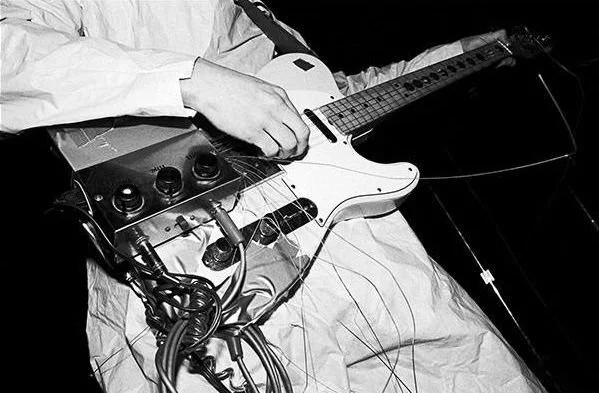Gut Feeling
by Seth Lorinczi
Ruby Ray, Mark Mothersbaugh performing with Devo, 1977. Courtesy of the artist.
Gut Feeling
Seth Lorinczi | AUG 2024 | Issue 36
In the 90’s I worked in an office in SoMa, San Francisco’s hip industrial zone. It wasn’t so hip back then: sun-bleached warehouses and body shops, the no-go zone beneath Highway 101. My employer was an online city guide, one of a thousand plucky startups staking their claim to the information superhighway. “In five years, the print weeklies will all be toast,” the editor-in-chief crowed. Twenty-five years later they’re still around, but the online guide’s been downgraded to a digital phonebook.
I liked my job—I wrote about the city’s restaurant scene—but outside work, it was hard to locate myself. I’d left my home in Washington, D.C. to clean up my act, get a real job, make something of myself. Still, an old feeling of separateness haunted me. Sometimes I wondered if I’d made a mistake leaving behind my friends in the punk scene, the music that gave my life meaning. Amidst the whirl of San Francisco’s flashy bars and art openings and deejayed house parties, I wasn’t sure if there was a place for me. Maybe not anywhere.
One Friday, word went around the office. Some well-funded startup with a horrific name—PersonSoft? PeopleTouch?—was celebrating their IPO with a block party. (We weren’t invited.) Later, strolling around the neighborhood, I heard the unmistakable sound of an electric guitar coming from a brick Quonset building. Must be rehearsing for the party, I thought.
As I drew closer and the sound became more distinct, something strange happened: my legs began moving faster of their own accord. The sound had coalesced into a song, and before I knew what I was doing I threw open the heavy metal door to the building and rushed inside.
Inside, it was cool, dark, and loud. As my eyes adjusted to the gloom, my ears basked in a glorious wash of sound. Across a field of black-and-white tiles was a stage, and on it stood five musicians. Each wore yellow jumpsuits and red ziggurat-like hats. They were, without any possible doubt, the band Devo.
I stood stock-still. I’m not sure, but I think my mouth hung open. Except for the band and the sound person I was the only one in the room. Hard as this was to comprehend, what was stranger still was that they were playing “Gut Feeling.”
“Gut Feeling” is an anthem about the vulnerability of desire and the power of intuition. It’s also my favorite Devo song. The feeling of penetration was so intense it was physically uncomfortable, and for a long moment I didn’t know whether I’d laugh or burst into tears.
The song ended. I bowed deeply to the band and then I walked back out into the sunshine. A silvery tone resonated through me, a tuning fork I’d given up for gone. Now that I’d located it, I vowed never to lose it again.
Seth Lorinczi’s writing appears in The Guardian, DoubleBlind, Narratively, and other print anthologies and periodicals. He’s also the author of Death Trip: A Post-Holocaust Psychedelic Memoir (Spiral Path Collective, 2024), a book about coming to grips with ancestral trauma through psychedelic therapy. In addition, he was a co-founder of “Judaism & The Psychedelic Renaissance,” a first-of-its-kind live event in Portland.
Ruby Ray is an American photographer, well known for her photography of the early punk, post-punk and industrial movements in California in the late 1970s and early 1980s. She began her photography career in 1977, when her photographs began appearing in Search & Destroy.
